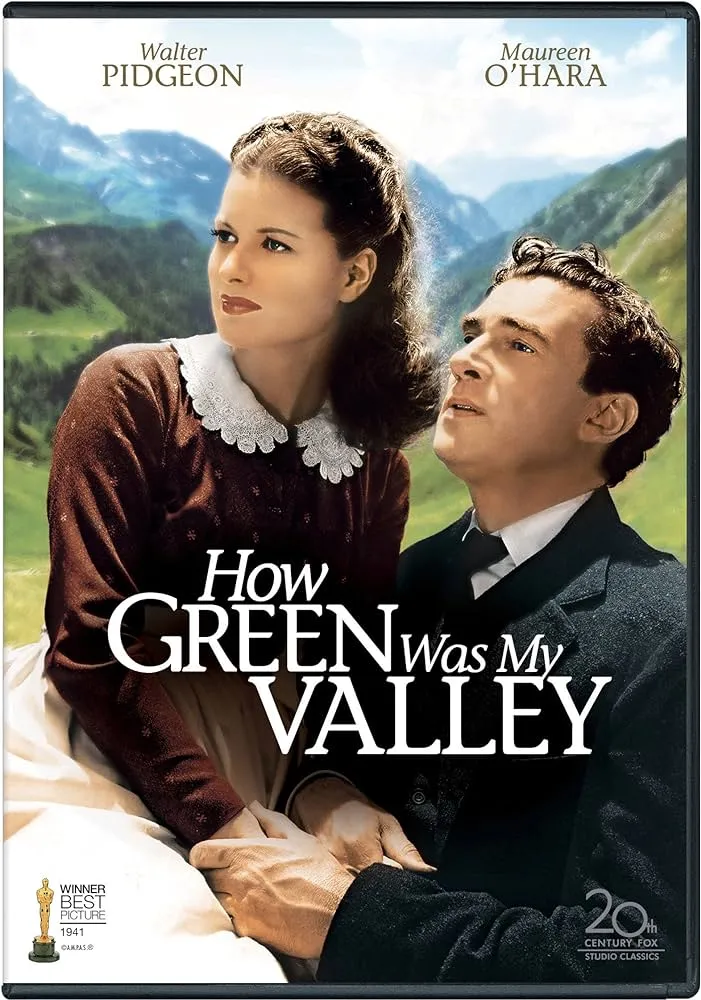
How Green Was My Valley is a 1941 American drama film set in Wales, directed by John Ford. The film is based on the bestselling 1939 novel of the same name by Richard Llewellyn and was produced by Darryl F. Zanuck.
It stars Walter Pidgeon, Maureen O'Hara, Anna Lee, Donald Crisp, and a very young Roddy McDowall. The film depicts the struggles of a Welsh mining family and has been praised for its sentimental human drama, despite the controversy surrounding its Best Picture win over Citizen Kane at the Academy Awards.
The film continues to be well-received and was added to the American National Film Registry in 1990. It has been described as a moving and impressive portrayal of the decline of a Welsh mining family, with a terrific cast and John Ford's directorial prowess. Despite the controversy, it is considered an emotionally powerful and beautiful film.
Plot
The film depicts the struggles of a Welsh mining family and stars Walter Pidgeon, Maureen O'Hara, Anna Lee, Donald Crisp, and a young Roddy McDowall. The story is narrated by Huw Morgan, the main character, and follows his family and the mining community in which they live.
Watch For Free
https://inleo.io/threads/view/taskmaster4450le/re-leothreads-k91deztz
If the video doesn't play on your browser, try another one. The videos work with Opera, Firefox, Chrome, and Edge. Some films take a bit to load so be patient.
Full Cast
- Main Cast:
- Roddy McDowall as Huw Morgan
- Walter Pidgeon as Mr. Gruffydd
- Maureen O'Hara as Angharad Morgan
- Donald Crisp as Gwilym Morgan
- Sara Allgood as Mrs. Beth Morgan
- Anna Lee as Bronwyn
- Patric Knowles as Ivor Morgan
- John Loder as Ianto Morgan
- Barry Fitzgerald as Cyfartha
- Supporting Cast:
- Morton Lowry as Mr. Jonas (Schoolmaster)
- Arthur Shields as Mr. Parry (Deacon)
There are many additional cast members in the film, including actors portraying Huw's brothers, villagers, and other characters.
Director: John Ford
Producer: Darryl F Zanuck
Writer: Philip Dunne
Distributor: 20th Century Fox
Box Office Gross: $380
Genre: Drama
Release Date (Theaters): Dec 27, 1941
Release Date (Streaming): Mar 1, 2013
Themes & Reception
How Green Was My Valley explores several themes, including the impact of industrialization on a close-knit community, the struggles of a Welsh mining family, and the changing social dynamics within the community. The film portrays the challenges faced by the mining community, the exploitation of workers, familial and societal expectations, and the environmental impact of mining activities.
The story is narrated by Huw Morgan, the youngest of seven children of a coal miner, and it follows his coming of age in a Welsh mining village at the turn of the century.
The reception of How Green Was My Valley has been mixed. While the film has been acclaimed by critics and is considered an abiding classic, it has also faced criticism for its historical inaccuracies and the sentimentality that brought controversy.
The novel, on which the film is based, has been criticized for not standing up from a strictly historical point of view, with parts being considered plain wrong. Despite this, the film continues to be well-received and was added to the American National Film Registry in 1990. The collaboration between director John Ford and composer Alfred Newman has also been praised, with Newman receiving an Academy Award nomination for his score.
Visual Styles & Techniques
The visual style of How Green Was My Valley has been described as darkly romantic, with cinematographer Arthur C. Miller using a high-contrast style in which the blacks are rich and deep, occasionally broken by the bright, pure light shining through the valley.
The film's imagery contrasts with the aching nostalgia and sentiment of Ford's vision. The movie's narrative evokes a range of emotions, touching the hearts of audiences and leaving a lasting impact.
The film's visual style contrasts the ugliness of "progress" with an idyllic lost world. Despite any challenges faced during production, the film is renowned for its powerful and emotional storytelling, beautiful cinematography, and stellar performances, which continue to resonate with audiences today.
Setting
The film How Green Was My Valley is set in a Welsh mining village at the turn of the century.
The setting provides a backdrop for exploring themes such as familial relationships, societal changes, and the challenges faced by the mining community. The film's setting serves as a crucial element in portraying the historical and cultural context of the characters' lives, contributing to the emotional depth and resonance of the narrative
Trivia
- The film famously beat Orson Welles' Citizen Kane to an Oscar.
- The author of the novel, Richard Llewellyn, claimed to have based the book on his own knowledge of the Gilfach Goch area, but this was proven false, as Llewellyn was English-born and spent little time in Wales. He actually gathered his facts from conversations with local mining families.
- The film was shot in black and white because the color of flowers in Southern California did not match those found in Wales.
- The movie is based on the novel "How Green Was My Valley" by Richard Llewellyn, published in 1939.
- The film was originally intended to be made in the UK, but World War II made it impractical, so it was shot in Southern California instead.
Fun Fact
A fun fact about "How Green Was My Valley" is that the film was originally intended to be made in the UK, but due to World War II, it was shot in Southern California instead. This decision led to the movie being filmed in black and white, as the colors of the flowers and other vegetation in California did not match those found in Wales.
Trailer
https://inleo.io/threads/view/taskmaster4450le/re-leothreads-22puj1psj
General:
Page by @iskafan